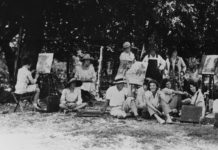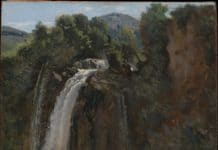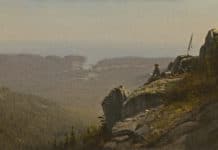
New England’s Aldro T. Hibbard was a tough man with the charisma to lead a new and vibrant art community in Rockport, Massachusetts. Bob Bahr wrote about the legendary plein air painter for the November 2012 issue of PleinAir magazine, and we offer a portion of that article here.

“The Village, Vermont,” no date, by Aldro T. Hibbard, oil, 26 1/2 x 36 in. Courtesy Pierce Galleries Inc., Nantucket and Hinghan, MA
He was a man’s man, hiking deep into the back country to paint, laying down bold colors with the square-brush technique. California had its Edgar Payne, but in New England, the preeminent plein air painter in the first half of the 20th century was Aldro T. Hibbard, a Cape Cod native who smoked big cigars, wore plaid work shirts, played baseball with loggers and lobstermen, and painted jewel-like landscapes in sub-zero temperatures. His fans, especially on the East Coast, remain fervid, and a show of more than 100 Hibbard paintings this fall at the Rockport Art Association, in Rockport, Massachusetts, is likely to kindle more interest in the artist.

“Log Team,” ca. 1930, by Aldro T. Hibbard, oil, 40 x 50 in. Courtesy Pierce Galleries Inc., Nantucket and Hingham, MA
Hibbard was by most accounts a very straightforward man and painter. Although he founded an art school in Rockport, he was not keen on discussing his particular working method. When asked what painting medium he used, he reportedly replied, “That’s not important. Just go out there and do it.” His color sense could range from muted to slightly exaggerated saturation, and he was best known for painting a seemingly monochromatic landscape element: snow. “He was noted for his snow paintings — they made him famous, and he is arguably the greatest snow painter from America,” asserts T. M. Nicholas, a Rockport painter and the chairman of the committee behind the upcoming Hibbard exhibition. “He keyed down the other elements in the painting to afford him more color in the snow. And his structure was very good — his drawing and values and tone were accurate.”

“Jamaica Village, Jamaica, VT,” by Aldro T. Hibbard, 1923, oil, 28 x 34 in. Collection of Tom and Gloria Nicholas.
Hibbard painted with a somewhat limited palette, and he often premixed colors before heading out for a painting session. He would scout out a scene to paint, then arrive on another day with the appropriate colors ready to go. His working method seemed to have followed one of two paths. Sometimes he would cart a large canvas out to the painting location and apply layers of paint thinned with turpentine, similar to how a watercolorist would work. He would finish the painting later in the studio. “He worked in colored stains, painting very thinly to get the right colors and values,” says Nicholas. “Then in the studio he would lay the fat paint on the skin.”

“Winter, Motif 1, Rockport,” by Aldro T. Hibbard, oil, 25 x 30. Collection of Dr. and Mrs. Joel E. Berenson.
Hibbard didn’t paint many scenes in Rockport, where he summered; he reportedly found all the greens oppressive. Instead, he taught at his school, and became very active in civic affairs. His studio was the first meeting place for the group of artists who formed the Rockport Art Association, and he served as the organization’s president for almost 20 years. And he served as a manager and player of the local baseball team. For more information on the exhibition of Hibbard’s paintings that will remain on view at the Rockport Art Association until November 11, 2012, visit www.rockportartassn.org.
Bob Bahr has been writing an editing articles about art instruction for more than eight years. He lives with his wife and two young sons at the northern tip of Manhattan.





What colors do you think he used?